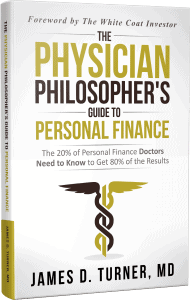As a PGY-4 in my anesthesiology residency, I easily doubled my salary by moonlighting in residency. Many opportunities exist for moonlighting, and the pay usually ranges from $60/hour to $150/hour depending on the nature of the call. Today, let’s hammer out the details of moonlighting in residency and discuss some helpful tips for moonlighting to make the most of the opportunity.
If you haven’t checked out the resident series of high-yield posts for residents, it is definitely worth your time! Or you can just read The Physician Philosopher’s Guide to Personal Finance.
Seek the right opportunities
 If we paint broad strokes, there are two categories of moonlighting. Internal moonlighting consists of opportunities to get paid for work you normally perform during the day. Often times the hospital will allow this because it is a cheaper option than hiring another medical professional (advanced practice provider, additional doctor, etc).
If we paint broad strokes, there are two categories of moonlighting. Internal moonlighting consists of opportunities to get paid for work you normally perform during the day. Often times the hospital will allow this because it is a cheaper option than hiring another medical professional (advanced practice provider, additional doctor, etc).
For example, in my residency training program we could stay and gain AE (“additional experience”) when the OR was tight and people were going to be getting off late. As a resident, you could choose to stay and make extra money continuing to sit the same case you were currently managing. Not a bad deal.
The other category of moonlighting is external moonlighting. This might consist of working in a local emergency room, ICU, or seeing consults. This is the kind of moonlighting I most often performed. It consisted of sleeping overnight in a small hospital and being available for any emergent events overnight.
Fortunately, the emergent events were quite rare, which is why this moonlighting gig earned the nickname of “sleeping for dollars.” That said, I did have to deal with events from time to time, including a PE and couple of patients who went into tachy-arrhythmias that required treatment.
Mostly, I got paid a decent wage for having the opportunity to study in a quiet room and sleep in an uncomfortable bed. They were paying for my availability.
You’d be surprised how useful your skill set is even with just a couple of years of training under your belt. Find the right opportunity that balances extra work, additional pay, and your already currently busy schedule.
Weigh Time versus Money
Before we get to the tips for making the most of your moonlighting pay, there are a couple of items to discuss.
First, I hope that you’ll consider the merits of living like a resident and consider saving money during residency from income you make while moonlighting. Saving money during this time matters. You could also use it to pay off student loan debt, if your debt to income ratio makes sense.
Second, please consider the additional weight of extra shifts on an already busy resident schedule. There is no reason to cause burnout. If you find yourself needing the extra money, consider the possibility of reducing your living expenses. Time is not money, and money sometimes isn’t worth your time.
This could serve the same function as earning more money. Don’t be Dr. Jones.
Alright, I am glad that disclaimer is out of the way. If you still have the desire to moonlight during residency, here is how to make the most of your additional income.
Tips for 1099 contractors
Moonlighting opportunities can be paid in one of two ways. We will discuss the first – being paid as a 1099 independent contractor – in this section. Then, we will discuss W-2 (employee) opportunities next. For those that aren’t sure, if you fill out a W-9 form, you are a 1099 worker. W-2 workers fill out W-4 forms.
Of note, make sure you understand quarterly estimated taxes if you are being paid as an independent contractor. Otherwise, you might experience a huge (unexpected) tax bill the following year.
1. Deduct Business Expenses
As an independent contractor (1099 income), you are considered self-employed by the IRS.
This provides one major advantage: tax deductions. Any business owner is allowed to deduct expenses that are necessary for running their business.
For a moonlighting resident, this might include a white coat, stethoscope, OR shoes, scrubs, and even a computer or laptop if it is used for work.
The only two requirements for deductions are that they must be “ordinary” and “necessary” to perform your job.
That said, if you are paid as a 1099 “self-employed” physician, you better make sure that your malpractice is covered by the hospital where you train, or that you purchase malpractice insurance on your own. Fortunately, these premiums can be deducted if you are left footing the cost.
2. Solo 401K > SEP IRA
This is more of a caution than an “advantage.”
 Being self-employed (1099), you can stuff additional money into this account even if you have maxed out your $19,000 limit for your 401K at your main job. Let’s be honest, though. You probably aren’t maxing that out as a resident. You should probably be using a Roth IRA anyway, unless you get a match in your 401K/403B at your hospital.
Being self-employed (1099), you can stuff additional money into this account even if you have maxed out your $19,000 limit for your 401K at your main job. Let’s be honest, though. You probably aren’t maxing that out as a resident. You should probably be using a Roth IRA anyway, unless you get a match in your 401K/403B at your hospital.
A solo or individual 401K is still a great option to save money during this time. If utilized in a pre-tax fashion, it will decrease your tax burden and it can also serve as a place to transfer any other IRA money that you might have (rollover IRA, SEP IRA, etc).
A solo-401K is preferred to a SEP IRA for one major reason: It doesn’t count against you when you perform a Backdoor Roth IRA later as an attending physician. This will become important as you become an attending physician earning more than ~$190,000 annually, where direct Roth contributions begin being phased out.
[Here is a tutorial for your first backdoor Roth IRA at Vanguard, if needed].
W-2 Employees
The other way you can get paid is as a W-2 “employee” for the hospital. If your moonlighting gig has you fill out a W-4 form, then you are a W-2 employee.
Being paid as an employee for moonlighting is likely the same as your residency paycheck. It has a few major advantages.
1. Employer paid FICA taxes
The 1099 independent contractor mentioned above will have a higher tax burden than a W-2 employee.
The reason is that when you are self-employed you have to pay both the employer and the employee side of Federal Insurance Contributions Act (FICA) taxes. In other words, the IRS views a 1099 working as employing themselves. Hence, you are both the employer and the employee.
In reality, this means you pay 6.2% for social security and 1.45% for medicare tax on the employee AND the employer side [2 x (6.2% + 1.45%)]. As a W-2 employee, you would only pay this once (the employee side).
Effectively, this means that the 1099 worker has a 7.65% higher tax rate. So, for every $1,000 that they take home, they will lose $76.50 to additional taxes that the W-2 worker will not have to pay.
Note: The social security tax only occurs until the wage base ($147,000 in 2022). After you make more than this, the 6.2% from the employee vanishes. This is why your take home paycheck goes up after you make more than this. It is also why side gigs as an attending physician are pretty sweet.
2. Employee Benefits
Another advantage of moonlighting during residency as a W-2 worker includes benefits.
You might have access to a 401K. They might provide matching. And you should absolutely take advantage of this, if they do. Otherwise, you are leaving part of your income on the table.
For example, let’s say they match 2% of your income and you make $50,000 moonlighting. If you contribute $1,000 to a 401K they will match that dollar for dollar. Many employers match contributions much higher than this.
You may also have other benefits, depending on the number of hours that you work.
Take Home
Moonlighting during residency can be great for supplementing your income. Before you take part, make sure you’ve weighed the cost. Then, look for the best opportunity that provides the balance you are looking for.
After that, make sure you understand whether you are a 1099 or W-2 worker. 1099 workers usually have to fill out a W-9 tax form. W-2 workers fill out a W-4.
Then, do what this site teaches you. Use your additional money to build wealth by paying down debt and investing for your future.
Are you moonlighting during residency? What tips and tricks do you have? For my attending physician readers, what would you have done differently if you could go back? Leave a comment below.
TPP





I wish I took advantage of some moonlighting opportunities (although because I was not financially savvy at the time I probably would have just spent it all).
In radiology there were some pretty sweet gigs available. A lot of facilities needed a doc to be on hand for contrast reactions (a fairly rare event) and could do a similar sleeping for dollars situation like yours.
I also knew of some radiology residents who actually did teleradiology preliminary reads for night coverage that paid fairly well. The pay was better but it was also a lot more interruptions.
I certainly took advantage of this! I moonlighted my CA-3 year AND during fellowship. In total I probably earned close to six figures moonlighting, which definitely helped me start paying off my student loans faster while contributing the max to my 401k and Roth IRA.
That’s the way to do it right there!